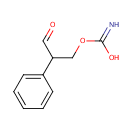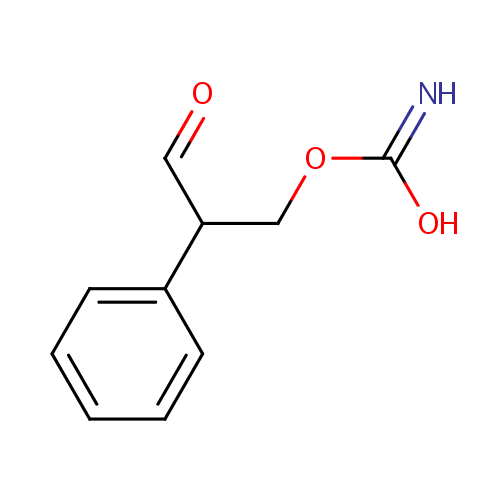|
Record Information |
|---|
| Version |
1.0 |
|---|
| Update Date |
1/22/2018 11:54:54 AM |
|---|
|
Metabolite ID | PAMDB000914 |
|---|
|
Identification |
|---|
| Name: |
3-Carbamoyl-2-phenylpropionaldehyde |
|---|
| Description: | 3-carbamoyl-2-phenylpropionaldehyde belongs to the class of Phenylacetaldehydes. These are compounds containing a phenylacetaldehyde moiety, which consists of a phenyl group substituted at the second position by an acetalydehyde. (inferred from compound structure) |
|---|
|
Structure |
|
|---|
| Synonyms: | - (3-oxo-2-phenyl-propyl) carbamate
- (3-oxo-2-Phenyl-propyl) carbamic acid
- (3-oxo-2-phenylpropyl) carbamate
- (3-oxo-2-Phenylpropyl) carbamic acid
|
|---|
|
Chemical Formula: |
C10H11NO3 |
|---|
| Average Molecular Weight: |
193.1992 |
|---|
| Monoisotopic Molecular
Weight: |
193.073893223 |
|---|
| InChI Key: |
XUCMSYZLYLONTH-UHFFFAOYSA-N |
|---|
| InChI: | InChI=1S/C10H11NO3/c11-10(13)14-7-9(6-12)8-4-2-1-3-5-8/h1-6,9H,7H2,(H2,11,13) |
|---|
| CAS
number: |
Not Available |
|---|
| IUPAC Name: | 3-(C-hydroxycarbonimidoyloxy)-2-phenylpropanal |
|---|
|
Traditional IUPAC Name: |
3-(C-hydroxycarbonimidoyloxy)-2-phenylpropanal |
|---|
| SMILES: | OC(=N)OCC(C=O)C1=CC=CC=C1 |
|---|
|
Chemical Taxonomy |
|---|
|
Taxonomy Description | This compound belongs to the class of organic compounds known as phenylacetaldehydes. These are compounds containing a phenylacetaldehyde moiety, which consists of a phenyl group substituted at the second position by an acetalydehyde. |
|---|
|
Kingdom |
Organic compounds |
|---|
| Super Class | Benzenoids |
|---|
|
Class |
Benzene and substituted derivatives |
|---|
| Sub Class | Phenylacetaldehydes |
|---|
|
Direct Parent |
Phenylacetaldehydes |
|---|
| Alternative Parents |
|
|---|
| Substituents |
- Phenylacetaldehyde
- Carboximidic acid derivative
- Hydrocarbon derivative
- Organooxygen compound
- Organonitrogen compound
- Imine
- Carbonyl group
- Aldehyde
- Aromatic homomonocyclic compound
|
|---|
| Molecular Framework |
Aromatic homomonocyclic compounds |
|---|
| External Descriptors |
Not Available |
|---|
|
Physical Properties |
|---|
| State: |
Not Available |
|---|
| Charge: | 0 |
|---|
|
Melting point: |
Not Available |
|---|
| Experimental Properties: |
|
|---|
| Predicted Properties |
|
|---|
|
Biological Properties |
|---|
| Cellular Locations: |
Cytoplasm |
|---|
| Reactions: | |
|---|
|
Pathways: |
Not Available |
|---|
|
Spectra |
|---|
| Spectra: |
|
|---|
|
References |
|---|
| References: |
- Kanehisa, M., Goto, S., Sato, Y., Furumichi, M., Tanabe, M. (2012). "KEGG for integration and interpretation of large-scale molecular data sets." Nucleic Acids Res 40:D109-D114. Pubmed: 22080510
|
|---|
| Synthesis Reference: |
Not Available |
|---|
| Material Safety Data Sheet (MSDS) |
Not Available |
|---|
|
Links |
|---|
| External Links: |
| Resource | Link |
|---|
| CHEBI ID | Not Available | | HMDB ID | HMDB60366 | | Pubchem Compound ID | 21350391 | | Kegg ID | C16587 | | ChemSpider ID | 19250426 | | Wikipedia ID | Not Available | | BioCyc ID | Not Available |
|
|---|


